Articles
- Page Path
- HOME > Korean J Community Nutr > Volume 16(6); 2011 > Article
-
Original Article
- Development and Effects' Analysis of Nutrition Education Pamphlet for the Lower Grades Elementary Students -Focused on Individual Daily Needed Food Exchange Units-
- Min-Jung Son, Young-Sook Cho, Se-Na Kim, Hye-Ji Seo, Sook-Bae Kim
-
Korean Journal of Community Nutrition 2011;16(6):647-660.
DOI: https://doi.org/10.5720/kjcn.2011.16.6.647
Published online: December 31, 2011
Graduate School of Education, Chonbuk National University, Jeonju, Korea.
1Department of Agrofood Resources, NAAS, RDA, Suwon, Korea.
2Department of Food Science & Human Nutrition, Research Institute of Human Ecology, Chonbuk National University, Jeonju, Korea.
- Corresponding author: Sook-Bae Kim, Chonbuk National University, 664-14, Duk-Jin Dong 1-Ga, Duk-Jin Gu, Jeonju 561-756, Korea. Tel: (063) 270-3823, Fax: (063) 270-3854, sbkim@jbnu.ac.kr
Copyright © 2011 The Korean Society of Community Nutrition
- 378 Views
- 0 Download
- 4 Crossref
Abstract
- The purpose of this study was to investigate effects of nutrition education program and pamphlet for the lower grades elementary students focused on individual daily needed food exchange units using Food Exchange System. Program consisted of four lessons (40 min/lesson), "5 major nutrients & function", "6 food group and sources", "daily needed food exchange units for normal body weight", and "smart snack choice and exercise". Pamphlet as activity book was developed for the program. The subjects were 3rd grade elementary students (educated group, 31 vs. non-educated group, 31). Educated group were lessoned as group and/or individual. We examined the differences in nutrition knowledge, dietary attitudes, dietary intakes and satisfaction of the program and pamphlet. In educated group, there were positive improvements on nutrition knowledge score "function and foods of 5 nutrients" and on dietary attitudes "type of breakfast and snacks". In the evaluation of dietary intakes according to KDRI, there were positive improvements on intakes level of riboflavin, vit. C, folate, Ca, P, Fe and Zn in educated group. In satisfaction with the program and pamphlet, contents, font size, visual, figure, difficulty and program curriculum were over 2.90/3.0. It showed that the developed nutrition education program and pamphlet focused on individual daily needed food exchange units using Food Exchange System improved nutrition knowledge, dietary attitudes and nutrients intake level in the lower grades elementary students.
-
This study was carried out with the support of "Cooperative Research Program for Agricultural Science & Technology Development (PJ006488)", Rural Development Administration, Republic of Korea.
NOTES
- 1. Choi JY. Effect of dietary life education program on nutrition knowledge and eating habit of elementary school third grade student. 2009; Cheongju National University; MS thesis.
- 2. Choi MK, Lee YS, Lee YS, Bae YJ, Kim MH, Lee YS, Kim AJ, Sung CJ. Evaluation of nutritional health camp in obese elementary students. Korean J Food Nutr. 2007; 20: 79-87.
- 3. Hong JK. A study on the professional guidance and counseling for children in elementary school. J Elementary Educ. 2002; 15(1): 1-20.
- 4. Hong SY. Basic Statistics. 2004; Seoul: Hakjisa.
- 5. Hur ES. Development of practical dietary education textbook and teaching manual in elementary school students. Korean J Community Nutr. 2010; 15(5): 636-647.
- 6. Jun JH. Effects of nutrition education on children with an unbalanced diet. 2001; University of Incheon; MS thesis.
- 7. Kim BH, Sung MY, Lee YN. Comparison of the nutrient intakes by the score of dietary action guides for Korean children among the elementary school students in Gwangju city. Korean J Community Nutr. 2011; 16(4): 411-425.
- 8. Jung IK. A Study on perception of teachers on the nutrition education in elementary school curriculum. J Korean Home Econ Educ Assoc. 2005; 17(4): 73-85.
- 9. Kim GM, Lee SY. The study on nutritional knowledge and eating behavior of elementary school senior students in Incheon area. J Korean Diet Assoc. 2000; 6(2): 97-107.
- 10. Kim JY, Han YS, Bae HY, Ahn HS. Dietary intakes and serum lipids and iron indices in obese children. Korean J Community Nutr. 2006; 11(5): 575-586.
- 11. Kim SB, Choi HJ. Effects of nutrition education using Food Exchange System: changes in elementary students' nutrition knowledge, dietary attitude and nutrients intake. Korean J Community Nutr. 2008; 13(6): 922-933.
- 12. Kim SH. Children's growth and school performance in relation to breakfast. J Korean Diet Assoc. 1999; 5(2): 215-224.
- 13. Kim YH, Ju HO. Elementary schoolers' skipping breakfast. Korean J Child Health Nurs. 2004; 10(4): 488-495.
- 14. Kyeon YK, Jang YA, Kim JW. Application of a practical nutrition education program, KHIDI KIDS, for the improvement of dietary attitudes and habits of elementary students. Korean J Nutr. 2006; 39(8): 808-816.
- 15. Lee JE, Jung IK. A study on eating habits of elementary school students and the perception on the nutrition education in curriculum. J Korean Home Econ Educ Assoc. 2005; 17(2): 79-93.
- 16. Lee KA. Activity-based nutrition education for elementary school students. Korean J Food Nutr. 2003; 36(4): 405-417.
- 17. Lee MJ, Jang MS, Lee JM. Analysis of recognized changes in performance and organizational environment by dietitians transposed to nutrition teachers in Gyeonggi province. J Korean Diet Assoc. 2008; 14(3): 243-258.
- 18. Lee YM, Lee MJ, Kim SY. Effects of nutrition education through discretional activities in elementary school -Focused on improving nutrition knowledge and dietary habits in 4th-, 5th- and 6th-grade students-. J Korean Diet Assoc. 2005a; 11(3): 331-340.
- 19. Lee YS, Lim HS, Ahn HS, Chang NS. Nutrition throughout the life cycle. 2005b; Paju: Kyomunsa.
- 20. Moon HN, Hong SJ, Shu SJ. The prevalence of obesity in children and adolescents. Korean J Food Nutr. 1992; 25(5): 413-418.
- 21. Mun YS, Jung EK, Yoon JY. A study on the intakes and perceptions of convenient breakfast. Korean J Community Nutr. 2011; 16(5): 559-568.
- 22. Park HS. Relation between obesity index and dietary pattern of 4-6 graders in Jeonbuk. 2006; Chonbuk National University; MS thesis.
- 23. Park YS, Lee JW, Seo JS, Lee BK, Lee HS. Nutrition education and counseling. 2010; Paju: Kyomunsa.
- 24. Rural Development Administration. The Korean Community Nutrition Society. Children's Nutrition Guide. 2009; Paju: Kyomunsa.
- 25. Shim JE, Paik HY, Moon HK. Breakfast consumption pattern, diet quality and health outcomes in adults from 2001 National Health and Nutrition Survey. Korean J Nutr. 2007; 40(5): 451-462.
- 26. Shin EK, Lee HS, Lee YK. Effect of nutrition education program in obese children and their parents(I), focus on anthropometric values and serum biochemical index. Korean J Community Nutr. 2004; 9(5): 566-577.
- 27. Son HS, Lee YK. Development and evaluation of an elementary school nutrition education program to prevent breakfast skipping. Korean J Community Nutr. 2010; 15(6): 740-749.
- 28. Son SM, Lee KH, Kim KY, Lee YN. Practices in nutrition education and counseling. 2007; Seoul: Life Science Publishing Co..
- 29. Trumbo P, Schlicker S, Yates AA, Poos M. Dietary reference intakes for energy, carbohydrate, fiber, fat, fatty acids, cholesterol, protein and amino acids. J Am Diet Assoc. 2002; 102(11): 1621-1630.PubMed
- 30. The Korean Nutrition Society. Dietary reference intakes for Koreans. 2010; Seoul: Han-Arum Publishing Co.
- 31. Yang IS, Chung HK, Chang MJ, Cha JA, Lee SJ, Chung LN, Park SH, Cha SM. Development of the educational program for Korean traditional food culture for the elementary students. Korean J Food Nutr. 2006; 12(2): 127-145.
- 32. Busan National University of Education, Department of Practical Arts Education. Playing food tower with Toto. 2010; cited 2010 August 10. Available from http://www.foodtower.net/.
- 33. Changwon National University, Department of Food and Nutrition. Jjang & food friend. 2010; cited 2010 August 10. Available from http://www.food79.net/.
- 34. Chungbuk National University, Applied Nutrition Laboratory. I Food. 2010; cited 2010 August 10. Available from http://ifood.or.kr/.
REFERENCES
Figure & Data
REFERENCES
Citations

- Effects of Nutrition Education Using Dietary Guidebook in Higher Grade Elementary Students of Jeonbuk Area
Mi-Ran Park, Sook-Bae Kim
Korean Journal of Community Nutrition.2018; 23(1): 13. CrossRef - Effects of Nutrition Education Providing School Lunch by Personalized Daily Needed Food Exchange Units for Adolescent Athletes in Jeonbuk Province
Kang-Mo Ko, Sook-Bae Kim
Korean Journal of Community Nutrition.2016; 21(1): 25. CrossRef - Effects of Nutrition Education for Chinese College Students in Korea - Focused on Personalized Daily Energy Requirement and Food Exchange Units -
Jia-Li Guo, Soon-Kyung Kim, Jeong-Weon Kim, Mi-Hyun Kim, Se-Na Kim, Sook-Bae Kim
Korean Journal of Community Nutrition.2013; 18(6): 565. CrossRef - Development and Effects' Analysis of Nutrition Education Pamphlet for the Higherr Grades Elementary Students -Focused on Individual Daily Needed Food Exchange Units-
Eun-Su Lim, Young-Sook Cho, Se-Na Kim, Sook-Bae Kim
Korean Journal of Community Nutrition.2012; 17(6): 689. CrossRef
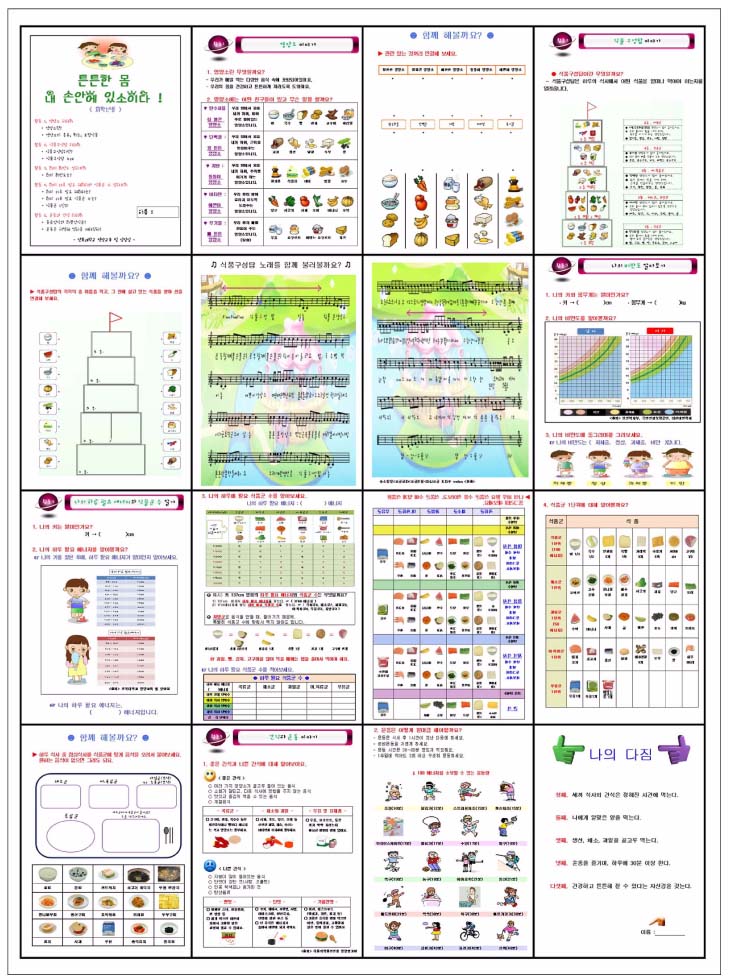
Fig. 1
Contents and tools of nutrition education program
Height, weight, obesity index of the subjects
1) Mean ± SD
2) Obesity index (%) = (Real weight - Standard weight) / Standard weight × 100
< -10% : underweight, -10% ≤ < 10% : normal, 10% ≤ < 20% : overweight, 20% ≤ : obese
3) N (%)
NS : Not Significant
Effects on nutrition knowledge of the subjects
1) Mean ± SD
2) by t-test
3) by ANCOVA test
*: p < 0.05, **: p < 0.01, ***: p < 0.001
NS: Not Significant
Score: non-corrected, 0; corrected, 1
Effects on dietary attitudes of the subjects
1) Mean ± SD
**: p < 0.01 by t-test
(R) denotes a negatively phrased and reversely scored item
NS: Not Significant
Score: seldom, 1; often, 2; frequent, 3; always, 4
Effects on type and frequency of meal and snack
1) N (%)
*: p < 0.05, **: p < 0.01 by chi-square test
NS: Not Significant
Effects on nutrients intake of the subjects
1) Mean ± SD
2) by t-test
3) by ANCOVA test
*: p < 0.05, **: p < 0.01, ***: p < 0.001
NS: Not Significant
Effects on energy, protein and fiber intake of the subjects
1) N (%)
EER: Estimated Energy Requirement
EAR: Estimated Average Requirement
RNI: Recommended Nutrient Intake
AI: Adequate Intake
NS: Not Significant by Mann-Whitney U Test
Effects on vitamins intake of the subjects
1) N (%), *: p < 0.05, **: p < 0.01, ***: p < 0.001 by Mann-Whitney U Test
EAR: Estimated Average Requirement, RNI: Recommended Nutrient Intake, UL: Tolerable Upper Intake Level, AI: Adequate Intake, NS: Not Significant
Effects on Minerals intake of the subjects
1) N (%), ***: p < 0.001, *: p < 0.05 by Mann-Whitney U Test
EAR: Estimated Average Requirement, RNI: Recommended Nutrient Intake, UL: Tolerable Upper Intake Level, AI: Adequate Intake, Goal: Population nutrient intake goal, NS: Not Significant
Satisfaction with developed program and pamphlet of the subjects
1) N (%)
2) Mean ± SD
Score: Dissatisfied 1, Normal 2, Satisfied 3
1) Mean ± SD 2) Obesity index (%) = (Real weight - Standard weight) / Standard weight × 100 < -10% : underweight, -10% ≤ < 10% : normal, 10% ≤ < 20% : overweight, 20% ≤ : obese 3) N (%) NS : Not Significant
1) Mean ± SD 2) by 3) by ANCOVA test *: NS: Not Significant Score: non-corrected, 0; corrected, 1
1) Mean ± SD **: (R) denotes a negatively phrased and reversely scored item NS: Not Significant Score: seldom, 1; often, 2; frequent, 3; always, 4
1) N (%) *: NS: Not Significant
1) Mean ± SD 2) by 3) by ANCOVA test *: NS: Not Significant
1) N (%) EER: Estimated Energy Requirement EAR: Estimated Average Requirement RNI: Recommended Nutrient Intake AI: Adequate Intake NS: Not Significant by Mann-Whitney U Test
1) N (%), *: EAR: Estimated Average Requirement, RNI: Recommended Nutrient Intake, UL: Tolerable Upper Intake Level, AI: Adequate Intake, NS: Not Significant
1) N (%), ***: EAR: Estimated Average Requirement, RNI: Recommended Nutrient Intake, UL: Tolerable Upper Intake Level, AI: Adequate Intake, Goal: Population nutrient intake goal, NS: Not Significant
1) N (%) 2) Mean ± SD Score: Dissatisfied 1, Normal 2, Satisfied 3

 KSCN
KSCN



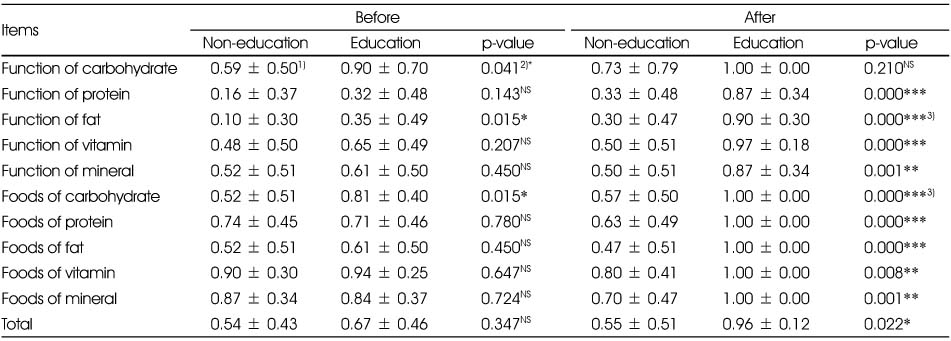

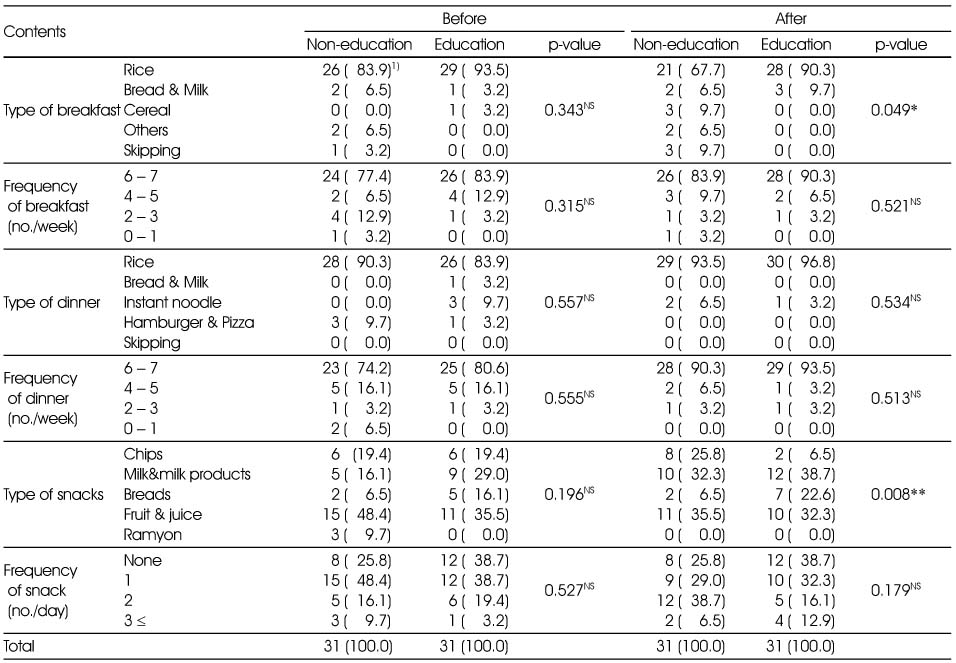
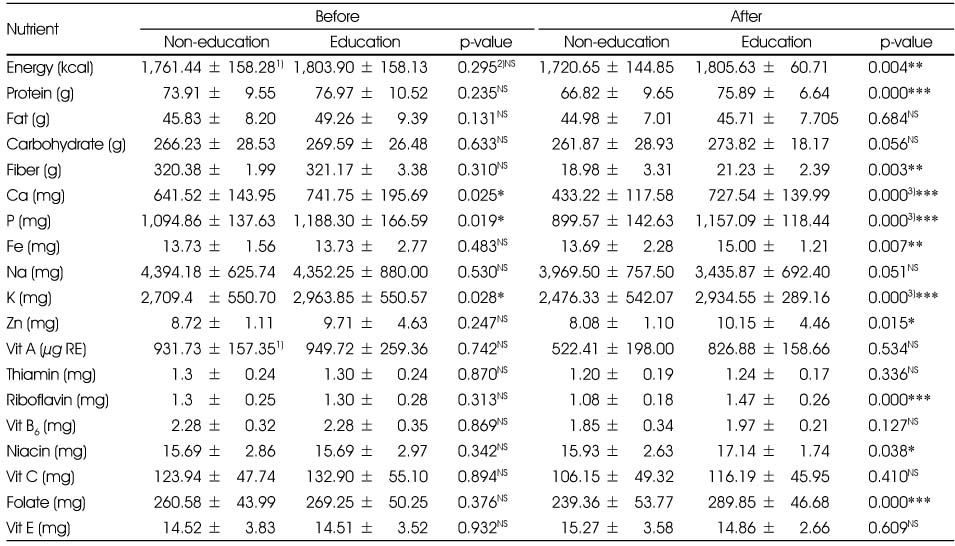

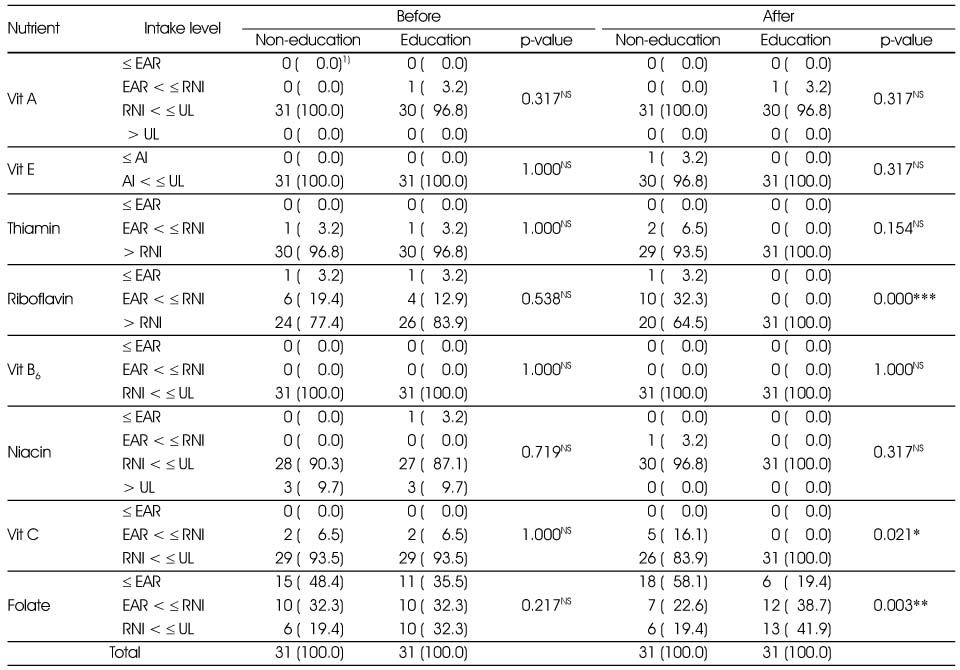
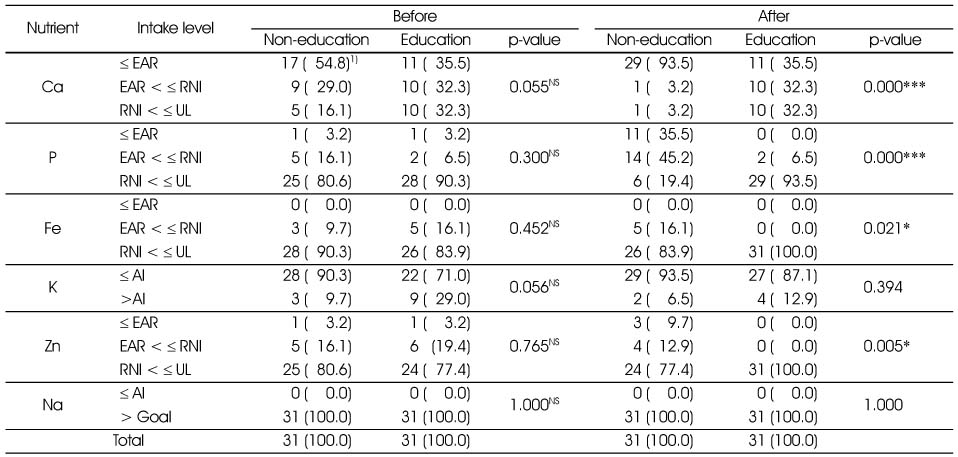
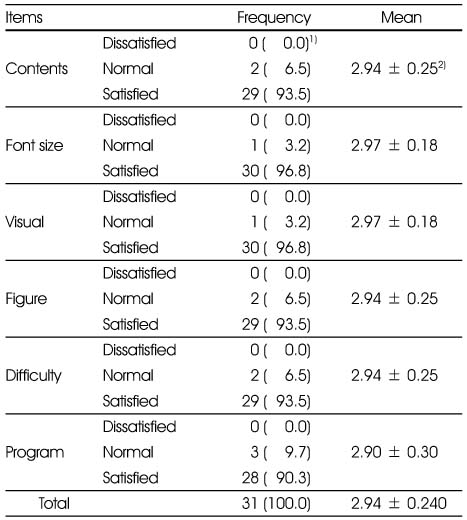
 PubReader
PubReader Cite
Cite


